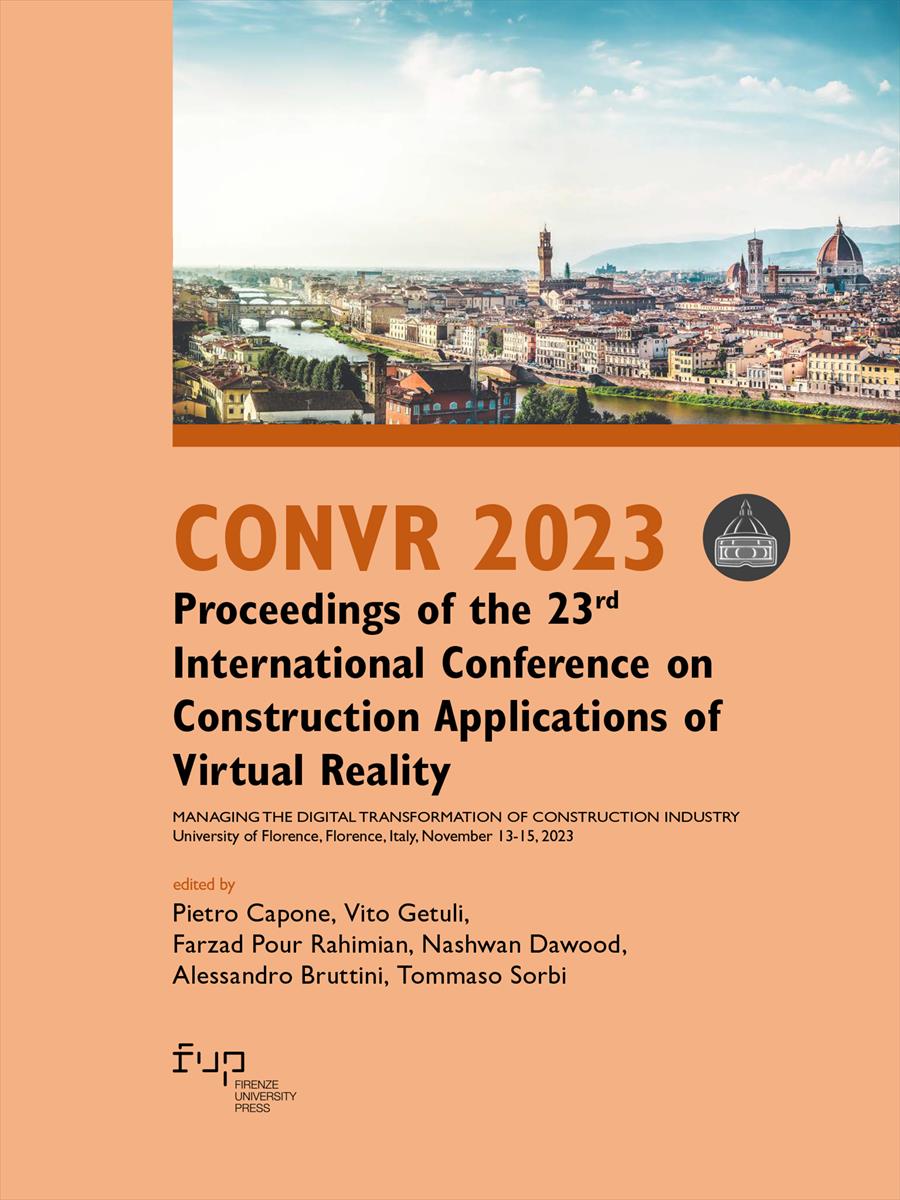- CONVR 2023 - Proceedings of the 23rd International Conference on Construction Applications of Virtual Reality
- Edited by Pietro Capone, Vito Getuli, Farzad Pour Rahimian, Nashwan Dawood, Alessandro Bruttini, Tommaso Sorbi
Integrating Green Roofs into Building Information Modeling (BIM): A Computational Approach for Sustainable Building Design
- Stefano Cascone
- © 2023 Author(s) |
- CC BY-NC 4.0
- DOI: 10.36253/979-12-215-0289-3.99
The construction industry is currently witnessing a transformative period characterized by the convergence of the green and digital transitions. The green transition seeks to address environmental challenges such as climate change and resource depletion, while the digital transition leverages advanced technologies to enhance construction processes. This paper specifically explores the integration of green roofs, as component of sustainable buildings, into the Building Information Modeling (BIM) framework, a key enabler of the digital transition. Green roofs, known for their environmental benefits, consist of layers that contribute to energy efficiency, stormwater management, and biodiversity enhancement. To optimize their design and performance, this research employs Dynamo Visual Programming Language (VPL) within Autodesk Revit to create parametric models of green roofs. These models facilitate the evaluation of thermal and structural characteristics under varying water content conditions (dry and saturated). Results reveal that the choice of substrate and drainage materials significantly impacts thermal resistance, particularly in dry conditions. However, in saturated conditions, the influence on thermal performance converges, emphasizing the importance of structural considerations in both scenarios. The research also highlights various limitations and outlines avenues for future studies, including expanding the range of materials, exploring additional performance metrics, and incorporating AI and machine learning techniques. By addressing these aspects, this research contributes to a comprehensive understanding of the integration of green roofs and BIM. It provides designers and researchers with a practical tool for optimizing green roof designs, aligning with contemporary sustainable construction practices, and promoting the holistic development of green buildings
- Keywords:
- Sustainability integration; Parametric modeling; Digital Transformation,
Mediterranea University of Reggio Calabria, Italy - ORCID: 0000-0002-6854-937X
- Alireza, A. F. F., Rashidi, T. H., Akbarnezhad, A., & Waller, S. T. (2017). BIM-enabled sustainability assessment of material supply decisions. Engineering, Construction and Architectural Management, 24(4), 668–695. DOI: 10.1108/ECAM-12-2015-0193
- Bherwani, H., Nair, M., Niwalkar, A., Balachandran, D., & Kumar, R. (2022). Application of circular economy framework for reducing the impacts of climate change: A case study from India on the evaluation of carbon and materials footprint nexus. Energy Nexus, 5, 100047. DOI: 10.1016/j.nexus.2022.100047
- Cascone, S. (2022). The energy-efficient design of sustainable green roofs in Mediterranean climate: An experimental study. Energy and Buildings, 273. DOI: 10.1016/j.enbuild.2022.112427
- Cascone, S., & Gagliano, A. (2022). Recycled agricultural plastic waste as green roof drainage layer within the perspective of ecological transition for the built environment. Journal of Cleaner Production, 380. DOI: 10.1016/j.jclepro.2022.135032
- Cascone, S., & Gagliano, A. (2023). A Novel Laboratory Procedure to Determine Thermal Conductivity of Green Roof Substrates. Smart Innovation, Systems and Technologies, 336 SIST, 66–75. DOI: 10.1007/978-981-19-8769-4_7
- Gimenez, L., Hippolyte, J. L., Robert, S., Suard, F., & Zreik, K. (2015). Review: Reconstruction of 3D building information models from 2D scanned plans. In Journal of Building Engineering (Vol. 2, pp. 24–35). Elsevier Ltd. DOI: 10.1016/j.jobe.2015.04.002
- Giovanardi, M., Konstantinou, T., Pollo, R., & Klein, T. (2023). Internet of Things for building façade traceability: A theoretical framework to enable circular economy through life-cycle information flows. Journal of Cleaner Production, 382. DOI: 10.1016/j.jclepro.2022.135261
- Huang, M. Q., Ninić, J., & Zhang, Q. B. (2021). BIM, machine learning and computer vision techniques in underground construction: Current status and future perspectives. Tunnelling and Underground Space Technology, 108. DOI: 10.1016/j.tust.2020.103677
- Kasmion, N. A., Wahab, I. A., Hamberi, M. J. M., Aziz, H. A., & Adnan, N. A. (2000). Simulation Studies on Heat Absorption of Container Green Roof Design Using BIM Urban Panning for libyan Cities View project Architectural Approach in Enhancing Natural Ventilation for Residential Building View project. Recent Trends in Civil Engineering and Built Environment, 0(0), 1–5. DOI: 10.30880/rtcebe.2020.01.01.006
- Korol, E., Shushunova, N., & Gorbachevskii, V. (2019). Optimization of green roof processes. IOP Conference Series: Materials Science and Engineering, 603(4). DOI: 10.1088/1757-899X/603/4/042074
- Mehrbod, S., Staub-French, S., Mahyar, N., & Tory, M. (2019). Characterizing interactions with BIM tools and artifacts in building design coordination meetings. Automation in Construction, 98, 195–213. DOI: 10.1016/j.autcon.2018.10.025
- Mina, H., Kannan, D., Gholami-Zanjani, S. M., & Biuki, M. (2021). Transition towards circular supplier selection in petrochemical industry: A hybrid approach to achieve sustainable development goals. Journal of Cleaner Production, 286. DOI: 10.1016/j.jclepro.2020.125273
- Shafique, M., Luo, X., & Zuo, J. (2020). Photovoltaic-green roofs: A review of benefits, limitations, and trends. In Solar Energy (Vol. 202, pp. 485–497). Elsevier Ltd. DOI: 10.1016/j.solener.2020.02.101
- Vijayaraghavan, K. (2016). Green roofs: A critical review on the role of components, benefits, limitations and trends. In Renewable and Sustainable Energy Reviews (Vol. 57, pp. 740–752). Elsevier Ltd. DOI: 10.1016/j.rser.2015.12.119
- Wang, H., Pan, Y., & Luo, X. (2019). Integration of BIM and GIS in sustainable built environment: A review and bibliometric analysis. In Automation in Construction (Vol. 103, pp. 41–52). Elsevier B.V. DOI: 10.1016/j.autcon.2019.03.005
- Yu, W. D., Cheng, S. T., Miao, C. M., & Perng, G. Y. (2017). Green innovation of green roof technology - a case study: Umweltverträgliche Dachtechnologie - eine Fallstudie. Materialwissenschaft Und Werkstofftechnik, 48(5), 420–429. DOI: 10.1002/mawe.201700015
Chapter Information
Chapter Title
Integrating Green Roofs into Building Information Modeling (BIM): A Computational Approach for Sustainable Building Design
Authors
Stefano Cascone
DOI
10.36253/979-12-215-0289-3.99
Peer Reviewed
Publication Year
2023
Copyright Information
© 2023 Author(s)
Content License
Metadata License
Bibliographic Information
Book Title
CONVR 2023 - Proceedings of the 23rd International Conference on Construction Applications of Virtual Reality
Book Subtitle
Managing the Digital Transformation of Construction Industry
Editors
Pietro Capone, Vito Getuli, Farzad Pour Rahimian, Nashwan Dawood, Alessandro Bruttini, Tommaso Sorbi
Peer Reviewed
Publication Year
2023
Copyright Information
© 2023 Author(s)
Content License
Metadata License
Publisher Name
Firenze University Press
DOI
10.36253/979-12-215-0289-3
eISBN (pdf)
979-12-215-0289-3
eISBN (xml)
979-12-215-0257-2
Series Title
Proceedings e report
Series ISSN
2704-601X
Series E-ISSN
2704-5846
